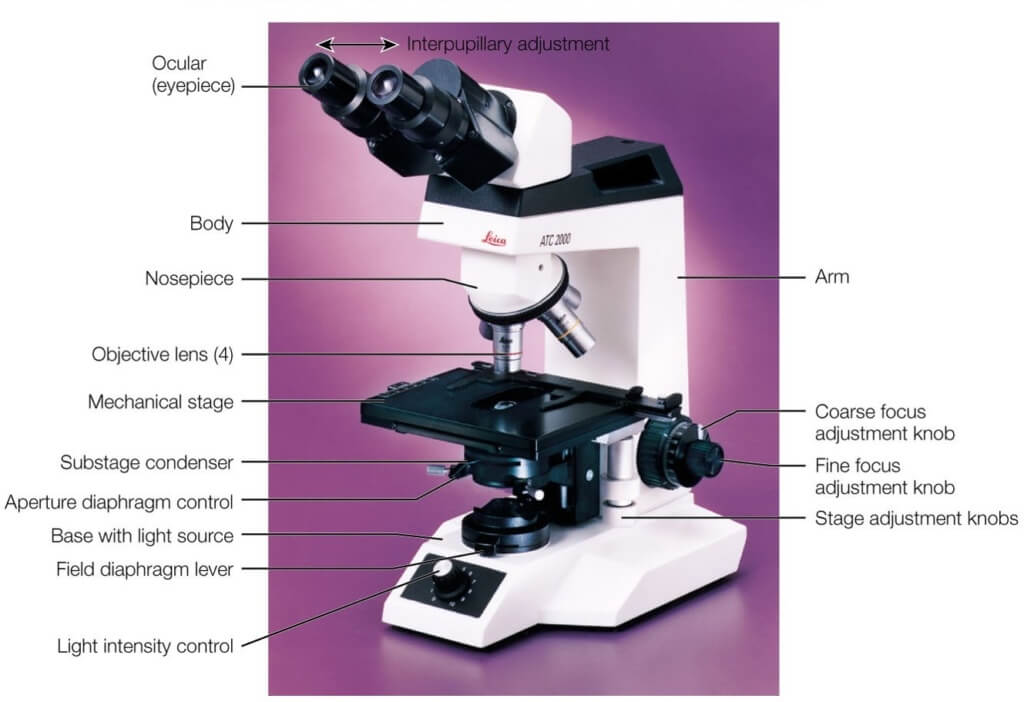Contents
ToggleUnderstanding Microscope Parts and Functions
The microscope is a sophisticated scientific instrument that looks difficult to use until you understand how each part works and what its purpose is. By studying the microscope diagram below and the brief explanation of the key parts, you will broaden your understanding and learn how to use your microscope with confidence.
Microscope Parts Labeled

The eyepiece lens (ocular lens) is the one on top where a user views or looks through the device; the eyepiece tube is the tube that connects the ocular lens to the objective lens section of the device itself. The eyepiece lens works with the objective lens to magnify the object.
Generally, a microscope contains three or four objective lenses with 4X, 10X, 40X, and 100X magnifying power; the role of the objective lens is to focus light rays at a specific place called the focal point.
The distance between the center of the lens and the focal point is the focal length and the power or strength of the lens is related to focal length, i.e. the shorter the focal length, the more magnification.
This part of the microscope is the one connecting the eyepiece or the top lens to the objective lens section.
The base is the bottom part of the microscope that supports the weight of the device.
The arm of the microscope attaches the tube to the base and provides structural support to the device; it is where users hold the microscope as well when they need to carry it from one place to another – one hand to hold the arm and the other hand under the base for better support.
An illuminator is a steady source of light used instead of a mirror; it normally uses low-volt bulb of 100 volts; if your microscope uses a mirror, then it is expected to utilise light from the surrounding environment.
This part is where doctors or scientists put the microscope slide with samples for analysis; it normally has clips that prevents a slide from moving while it is being viewed by the user from the eyepiece part; the slide can be moved manually while it is being viewed or it can be moved mechanically if you are using a microscope with a mechanical platform; this is done by rotating the knobs which can either move the slide sideways or upward and downward.
As discussed above, this part of the microscope prevents the microscope slides from moving or falling.
This part has 2 or more objective lenses that allows users to rotate the lenses based on the power that they need to use.
This is the part that moves or adjusts the objective lenses closer or away from the platform or microscope slide; this has to be used properly as moving the objective lenses too close to the platform or slide can break the slide or damage the objective lens.
A condenser lens collects the light coming from the illuminator and focuses it on the slides or the specimen being viewed and analyzed; a condenser lens provides a crispier or a clearer view of the specimen than the ones with no condenser lens for better resolution up to 1000 times magnification.
In more advanced microscopes an Abbe condenser is used; this provides a cone of light to the object of correct size and angle.
The iris or diaphragm regulates the light that reaches the specimen for better view and analysis.
This knob is located on the microscope’s arm; this is used to adjust the slide with specimen to put it in the best position for proper viewing; a user would normally turn the knob several times until he gets the image that he wants; the coarse adjustment knob should be turned slowly and carefully to get the best view and prevent any damages to it.
This is part of the coarse adjustment knob which is also used to get a better view of the microscope slide with the specimen being analyzed.
This is used to turn on or off the light coming from the illuminator.
How Microscopes Work and How to Use One
Light
Light is a wave and the amplitude determines the brightness, while wavelength determines the colour and frequency is number of waves per second.
The size of an image is determined by the angle of light entering the eye, and the glass lens used in microscopes slows the light. In technical terms, the wavelength becomes shorter and light bends, this is called refraction.
Resolution
The smallest distance that can be distinguished between two points is called resolution. Resolution is equal to 0.6 x wavelength/numerical aperture, therefore, the shorter the wavelength the greater the resolution.
However, resolution is limited by the numerical aperture, which is the light gathering capacity of the lens.
How to Use a Microscope
A full step-by-step guide on how to use a microscope is available here. However, here is a drastically simplified version:
Step 1: Fully open field and condenser diaphragms and focus on specimen using x10 objective.
Step 2: Fully close field diaphragm and adjust the condenser and focus so edges are as sharp as possible
Step 3: Use screws at front of condenser to centre field diaphragm and open field diaphragm to fill view
Step 4: Remove eyepiece and close down aperture diaphragm, open the diaphragm to fill approximately one third of view
Step 5: Replace the eyepiece and alternate between the different eyepieces as necessary
Microscopes - A Remarkable Invention
There was a time in our history when we were not aware of the tiniest living organisms on the planet. We did not pay attention to them as we did not know they existed in the first place.
But the invention of the microscope changed this dramatically and we have gone a long way since then, discovering microbes and the organelles of the mammalian cell.
They truly are a remarkable feat of human engineering and scientific discovery and yet there is so much more to know!
